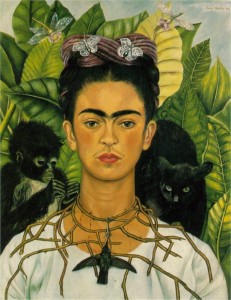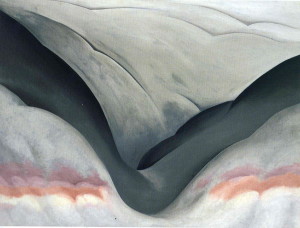Born: July 6, 1907 in Mexico City, Mexico; Died July 13 1954 in Mexico City, Mexico
I think it’s only fitting to finish this series with one of the most famous (and flamboyant) female artists to date– Frida Kahlo. Largely a household name, Kahlo’s paintings are easily recognizable. I’m sure many of you, in fact, noticed that the icon of this website is one of her self portraits. But why has this artist become so renowned?
A great amount of her prestige is certainly due to her incredibly unusual, beautiful artwork. But, I think a lot of the fascination with Frida comes from her dramatic life and unorthodox character. From her unstable relationship with fellow artist Diego Rivera, to her numerous affairs with both men and women, Kahlo clearly lived her life according to her own principles.
Kahlo’s father was a German photographer who met her mother while in Mexico. They lived in what is referred to as the “Blue House,” or the”Casa Azul,” in Spanish. It was there that they raised their four daughters, including the young Frida, who suffered from polio. The disease left her foot badly injured, causing her father to urge her to take up sports like wrestling to recover. These actives were, of course, unusual for a girl of that time, but Frida was very fond of her brazen father.
IMAGE?
In 1922, at the age of 15, Kahlo was admitted to the National Preparatory School in Mexico. While there, she came across the famed muralist Diego Rivera, whom she immediately felt a connection to, despite him being 20 years her senior. She admired his work from afar, but the two had yet to truly start their infamous relationship. Instead, Kahlo spent her time with friends, immersing herself in the Communist ideas she found so fascinating.
Kahlo experienced a life-changing event in 1925– she was impaled after getting in a streetcar accident, and was (obviously) severely injured. During her recovery, she began to really gravitate toward painting, making some of her first self portraits. She gave her friend, Gómez Arias, who was also involved in the accident.
Self Portrait in a Velvet Dress, 1926
Soon after the accident, Kahlo became closer with the artist she so venerated, Diego Rivera. The two began a romantic relationship that was rife with dysfunction from the onset, though they were very similar in their beliefs and support of Communism. Nonetheless, the it seems as though the artists truly loved each other, and got married in 1929. They moved to America where they traveled for years, displaying their work in different major cities.
Frida and Diego, 1931 Feast of Santa Anita, 1931
The image on the left is one of Frida’s pieces, while the one on the right is a mural painted by Rivera. I think Frida’s piece, though a bit elementary because it’s from the earlier stages of her career, is really fascinating to observe. She actually captures both her and Diego’s faces very, very well, and paints him holding a palate and a set of brushes, yet she is without any artistic materials. Whether or not this was intentional, I’m not sure, but I think it represents just how much she almost idolized Rivera and his work. Feast of Santa Anita, which Rivera painted in San Francisco, is beautiful, rich, and obviously representative of his Mexican heritage.
As I alluded to before, Frida and Diego’s marriage was not a simple one. He often cheated on her with other women, including her own sister, which deeply hurt the artist. She isn’t exempt from this behavior, though, as she also had numerous affairs with many people, both men and women (perhaps even with the last artist on my blog, Georgia O’Keeffe!) Kahlo also experienced heartbreak with her several miscarriages, which inspired some of her works.
Henry Ford Hospital, 1932
Though deeply unsettling, this piece shows just how personal and illustrative Kahlo’s paintings were. She was unafraid to depict even the most private elements of herself on canvas.
In 1939, Kahlo moved to Paris alone, where she exhibited many pieces. She also struck up a friendship with artist Pablo Picasso, who admired her pieces. In fact, while Picasso was enjoying one of her works while in the presence of Rivera, the muralist “actually welled up with tears of pride” for his wife. The two divorced in 1939, but remarried only a year later.
Regarding her own work, Frida never really categorized her style, besides noting that her paintings were the “frankest expression of myself”. Famed surrealist Andre Brenton, who admired her work, tried to convince her she was, in fact, a surrealist, while her husband firmly believed she was a realist. Though they did not always see eye to eye, Frida and Diego felt immense work for each other, especially in an artistic sense– with “each regard[ing] the other as Mexico’s greatest painter.” In this sense, the two were a very logical fit for each other in their love of life, art, social revolution, and their native land of Mexico.
Self portrait with Thorn Necklace and Hummingbird, 1940
Though this painting appears rather placid and simple at first glance, it has a much heavier significance as one notices the still (likely dead) hummingbird tied around her neck and the thorns piercing her skin. Like many of her other works, Self Portrait with Thorn Necklace symbolizes, mainly, the immense suffering and pain Frida felt throughout her life, whether physically, as with her injuries and miscarriages, or emotionally, stemming greatly from her relationship with Diego, who she once referred to as a “great accident”. Frida’s pieces capture a glimpse into a highly creative mind with a thirst for adventure, that also sadly harbored a great deal of unhappiness.
Frida’s poor health caught up to her, and by the late 1940s, she was in very bad shape. The artist suffered from illnesses like gangrene, but still persisted with her career, once arriving to a gallery showing in an ambulance. She wasn’t able to paint as easily as she once could, but overcame these obstacles with her strong love for art. In 1954, at the age of 47, Kahlo died in the same house she was raised. Her cause of death is not entirely agreed upon; some think she killed herself, while most believe that it was a pulmonary embolism.
Throughout her life, the people of Mexico cherished Kahlo for her depiction of Mexican life and love of her culture. She is seen as “la heroína del dolor, ‘the heroine of pain’” in the country, where the symbolism of her work is entirely appreciated. There was a rebirth of interest in Kahlo in the 1970s, when she became an icon for feminists and independent women.
I think that Frida’s feelings behind every piece are evident to some degree to every viewer. There is clear pain and sorrow in many of her pieces, but the whimsy, the colors, the richness…. All of this shows a true love of life and appreciation for existing. I feel like Kahlo didn’t squander one moment of her life, living fully and without constraint, despite the controversy it may arouse. I don’t agree with everything she did in life, and I don’t want to romanticize her as just another tortured artist, but I think the fact that she created something so beautiful and enduring out of her pain is a testament to humankind’s immense potential.
URLS:
http://www.pbs.org/weta/fridakahlo/life/
http://www.biography.com/people/frida-kahlo-9359496#deteriorating-health-and-death
http://www.vanityfair.com/culture/1995/09/frida-kahlo-diego-rivera-art-diary
http://www.fridakahlo.org/self-portrait-with-thorn-necklace-and-hummingbird.jsp
http://www.thefamouspeople.com/profiles/frida-kahlo-de-rivera-1437.php












